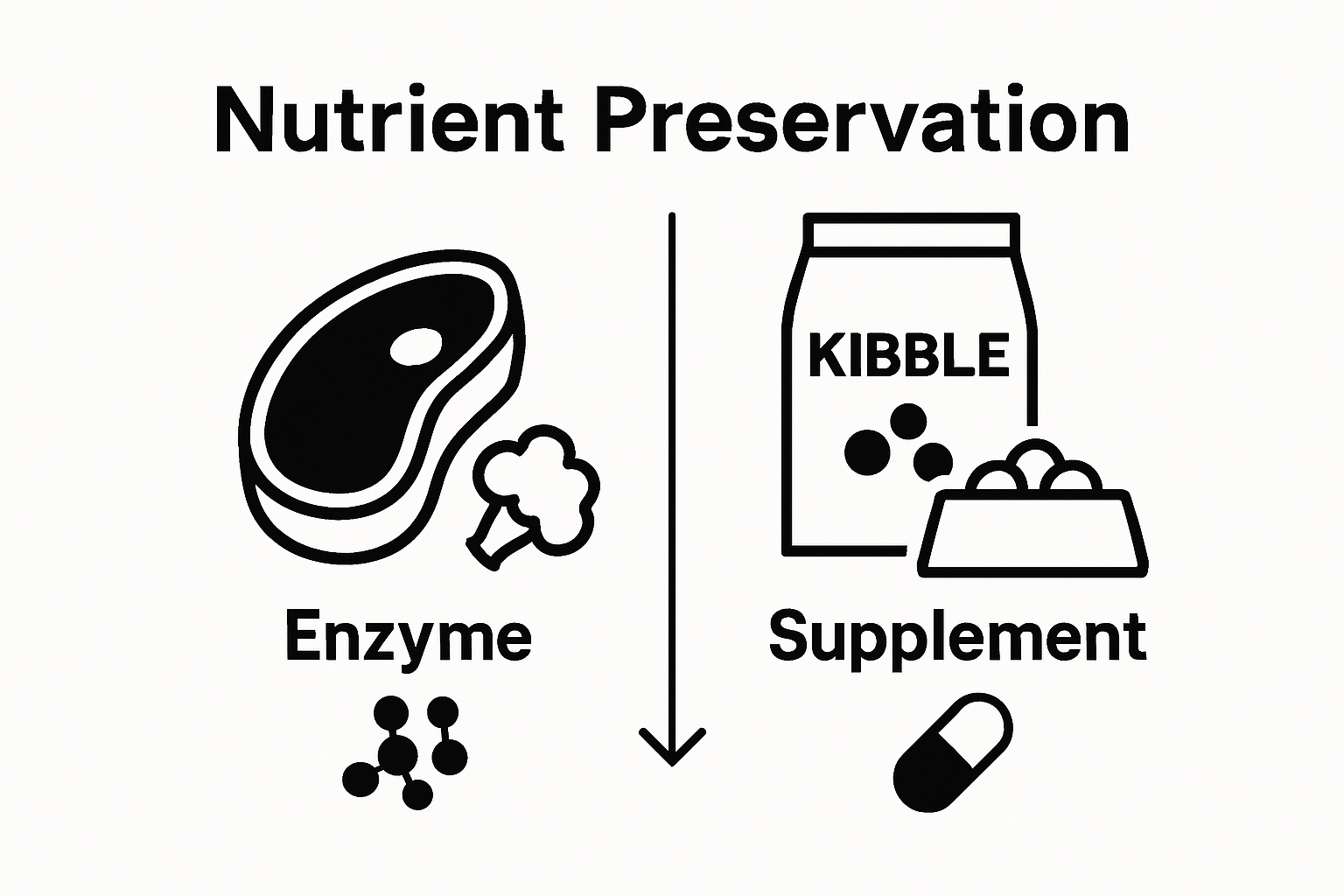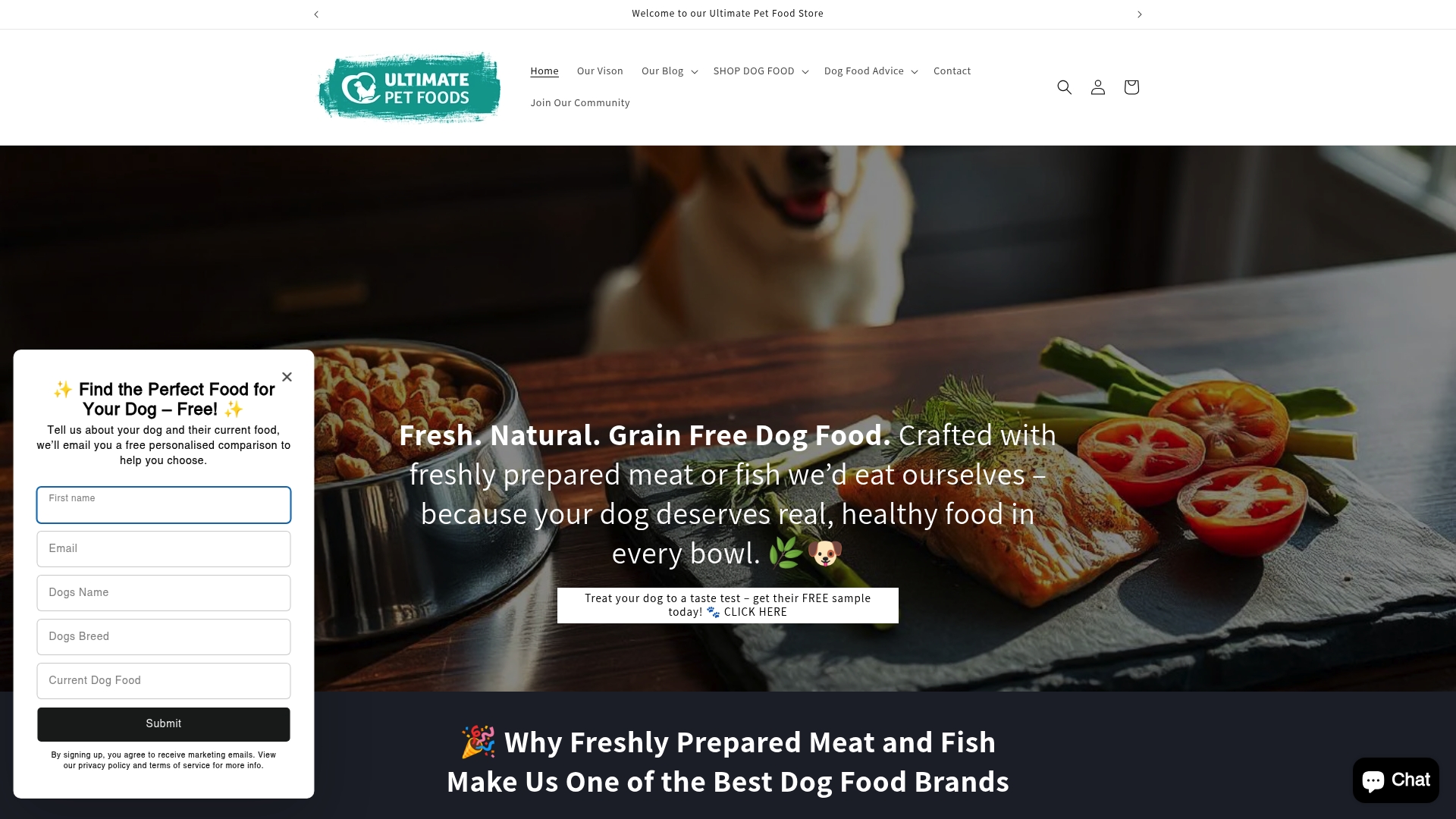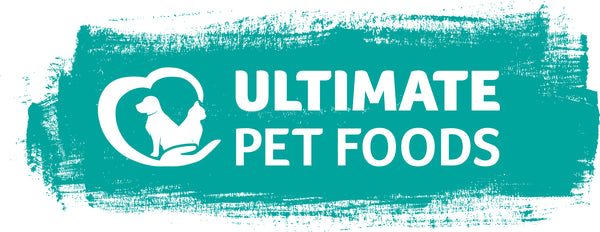
Understanding Raw vs Kibble Dog Food: Key Insights
Share
Choosing between raw dog food and kibble seems simple enough. Yet, nearly 70 percent of commercial dog food is kibble, while a fast-growing number of pet parents are switching to raw diets for their dogs. Most people never realize that the biggest nutritional difference comes not from the type of food, but from how each one is processed and what that does to your dog’s health.
Table of Contents
- What Is Raw Dog Food And Kibble?
- Nutritional Differences Between Raw And Kibble Dog Food
- Why Choosing The Right Dog Food Matters
- The Impact Of Diet On Dog Health And Behavior
- Evaluating Your Dog’s Specific Needs For Food Choices
Quick Summary
| Takeaway | Explanation |
|---|---|
| Understand raw vs. kibble | Raw dog food is unprocessed, while kibble is processed through high-heat extrusion. |
| Evaluate nutritional value | Raw food may provide higher protein quality and nutrient preservation compared to kibble. |
| Consider dog’s specific needs | Tailor your dog’s diet based on breed, life stage, and health status for optimal nutrition. |
| Monitor health impacts | Nutrition influences not just physical health but also cognitive function and behavior in dogs. |
| Consult veterinary advice | Always seek guidance from a veterinarian for personalized dietary recommendations for your dog. |
What is Raw Dog Food and Kibble?
Understanding the fundamental differences between raw dog food and kibble is crucial for pet owners seeking optimal nutrition for their canine companions. These two primary dog food categories represent distinctly different approaches to feeding dogs, each with unique characteristics and potential benefits.
Defining Raw Dog Food
Raw dog food is a dietary approach that mimics the ancestral diet of dogs, consisting of uncooked, minimally processed ingredients. This nutritional strategy typically includes raw meat, bones, organs, and sometimes small amounts of fruits and vegetables. Learn more about digestive health and nutrition to understand how diet impacts your dog’s overall wellness.
Key components of raw dog food often include:
- Fresh, uncooked muscle meat
- Raw organ meats
- Whole or ground bones
- Raw eggs
- Fresh produce
The philosophy behind raw dog food centers on providing nutrition in its most natural state, believing that cooking destroys essential nutrients and enzymes that support canine health.
Understanding Kibble
Kibble represents the most common commercial dog food format. These are dry, processed food pellets created through an industrial manufacturing process called extrusion. During production, ingredients are mixed, subjected to high heat and pressure, then cut into small, uniform pieces and dried.
The manufacturing process for kibble involves:
- Mixing protein sources (meat meal, grains)
- Adding vitamins and mineral supplements
- Applying high heat
- Forming uniform pellets
- Drying and coating with flavor enhancers
While kibble offers convenience and longer shelf life, the extensive processing can potentially reduce the nutritional value of its original ingredients. The high-temperature cooking method may degrade some natural nutrients, necessitating synthetic vitamin and mineral supplementation.
Both raw and kibble diets have passionate advocates, and the choice depends on individual dog needs, owner preferences, and veterinary guidance. Understanding these options empowers pet owners to make informed nutritional decisions for their furry companions.
To clarify the main distinctions between raw dog food and kibble, the following table compares key characteristics, processing methods, and nutritional impacts of each option.
| Feature | Raw Dog Food | Kibble |
|---|---|---|
| Processing Method | Uncooked, minimally processed | High-heat extrusion, highly processed |
| Protein Quality | High-quality, undenatured, more bioavailable | May be degraded by heat, lower bioavailability |
| Nutrient Preservation | Retains natural enzymes, vitamins, and minerals | Some nutrients lost, relies on synthetic supplements |
| Main Ingredients | Fresh meat, bones, organs, eggs, fresh produce | Meat meal, grains, added supplements, flavor enhancers |
| Shelf Life | Shorter, requires refrigeration | Longer, shelf stable at room temperature |
| Convenience | Requires preparation, more perishable | Ready-to-serve, highly convenient |
| Potential Risks | Higher risk of bacterial contamination | Lower risk due to high-heat processing |
Nutritional Differences Between Raw and Kibble Dog Food
The nutritional composition of raw and kibble dog food reveals significant variations that impact canine health, digestion, and overall wellness. Understanding these differences helps pet owners make informed dietary choices for their dogs.
Protein Quality and Bioavailability
Protein represents a critical nutritional component in dog diets, with notable distinctions between raw and kibble sources. Raw dog food typically offers high-quality, unprocessed protein with enhanced bioavailability, meaning dogs can more efficiently absorb and utilize these nutrients. Learn how to read dog food ingredients to better understand protein sources.
Raw protein sources generally provide:
- Whole, undenatured protein structures
- Higher enzymatic activity
- More intact amino acid profiles
- Minimal processing degradation
- Natural protein composition
In contrast, kibble proteins undergo significant thermal processing, which can reduce protein quality and denature essential amino acids. The extrusion process subjects proteins to high temperatures, potentially compromising their nutritional integrity.
Nutrient Preservation and Enzymatic Content
The manufacturing process dramatically impacts nutrient preservation between raw and kibble dog foods. Raw diets maintain natural enzymatic structures and nutrient profiles, offering potentially superior nutritional benefits. High-temperature kibble production can compromise vitamin and mineral content, necessitating synthetic supplementation.
According to research from the UK Food Standards Agency, raw diets present unique challenges. While offering potentially more natural nutrition, they also introduce higher risks of bacterial contamination and potential pathogen transmission.
Key nutritional differences include:

- Enhanced enzyme retention in raw foods
- Reduced nutrient degradation
- More natural vitamin and mineral profiles
- Lower reliance on synthetic supplements
- Potential increased digestibility
Ultimately, the choice between raw and kibble depends on individual dog health requirements, owner preferences, and veterinary recommendations. Pet owners should consult nutrition experts to determine the most appropriate diet for their specific canine companion.
Why Choosing the Right Dog Food Matters
Selecting the appropriate diet for your dog is far more than a simple feeding routine. It represents a critical decision that directly influences your canine companion’s long-term health, energy levels, and overall quality of life. Understand the foods to avoid for optimal health to make informed nutritional choices.
Impact on Physical Health
The nutritional foundation of a dog’s diet plays a pivotal role in maintaining optimal physical condition. Proper nutrition supports crucial bodily functions, from muscle development to immune system performance. A well-balanced diet can prevent numerous health complications and contribute to a dog’s overall resilience.
Key physical health considerations include:
- Muscle maintenance and development
- Immune system strength
- Metabolic efficiency
- Coat and skin health
- Bone density and joint support
According to research from the University of Bristol, dietary choices can significantly impact a dog’s long-term health, with potential risks associated with certain feeding approaches.
Cognitive and Behavioral Implications
Nutrition extends beyond physical wellness, profoundly affecting a dog’s cognitive function and behavioral patterns. Proper nutrient intake supports brain health, potentially influencing learning capabilities, emotional stability, and overall mental acuity.
Dogs receiving balanced nutrition typically demonstrate:
- Enhanced cognitive function
- More stable emotional responses
- Improved stress management
- Better learning and training receptivity
- Increased overall mental clarity
The nutritional choices pet owners make today can have lasting implications for their dog’s future health and well-being. Consulting with veterinary nutritionists and understanding individual dietary needs becomes paramount in making informed decisions that support a dog’s holistic health journey.
The Impact of Diet on Dog Health and Behavior
Dog nutrition transcends mere sustenance, representing a complex interplay between dietary intake and comprehensive physiological and psychological wellness. The food a dog consumes directly influences their physical performance, mental state, and long-term health trajectory. Learn about holistic dog nutrition strategies to optimize your dog’s dietary approach.
Nutritional Influence on Physiological Systems
Dietary composition plays a critical role in modulating various physiological systems within a dog’s body. Nutrient balance impacts everything from cellular regeneration to hormonal regulation, creating a profound interconnection between nutrition and overall health.
Key physiological systems influenced by diet include:
- Immune system functionality
- Endocrine system balance
- Metabolic processing
- Neurological function
- Digestive system efficiency
According to research from the University of Bristol, dietary choices can significantly impact a dog’s long-term health, highlighting the importance of mindful nutritional selection.
Behavioral and Cognitive Implications
Nutrition extends its influence beyond physical parameters, demonstrably affecting a dog’s behavioral patterns and cognitive capabilities. Nutrient deficiencies or imbalances can manifest as mood fluctuations, reduced learning capacity, and altered stress responses.
Behavioral aspects influenced by diet encompass:
- Emotional stability
- Stress resilience
- Cognitive processing speed
- Energy regulation
- Social interaction patterns
The intricate relationship between diet and canine well-being underscores the necessity of comprehensive nutritional strategies. Pet owners must recognize that each meal represents an opportunity to support their dog’s holistic health, requiring careful consideration of individual nutritional needs, breed-specific requirements, and potential health sensitivities.
Evaluating Your Dog’s Specific Needs for Food Choices
Selecting the optimal diet for a dog requires a nuanced understanding of individual nutritional requirements that extend far beyond generic feeding recommendations. Personalized nutrition becomes paramount in supporting each dog’s unique physiological and metabolic profile. Learn about food choices for sensitive dogs to refine your approach.
Breed and Life Stage Considerations
Different dog breeds and life stages demand distinct nutritional frameworks. Puppies, adult dogs, and senior canines have markedly different metabolic needs, requiring tailored dietary strategies that support their specific developmental and aging processes.
Key nutritional variations across life stages include:
- Protein concentration requirements
- Caloric density
- Mineral and vitamin proportions
- Digestibility factors
- Energy metabolism rates
According to research from the University of Bristol, dietary selections profoundly impact long-term health outcomes, emphasizing the importance of precise nutritional planning.
Health Status and Individual Sensitivities
Individual health conditions significantly influence dietary requirements. Dogs with allergies, metabolic disorders, or specific medical challenges necessitate carefully curated nutrition plans that address their unique physiological constraints.
Critical health factors influencing dietary choices encompass:
- Allergenic sensitivities
- Metabolic disorders
- Digestive system functionality
- Immune system responsiveness
- Weight management needs
Successful nutritional strategies demand comprehensive assessment, including veterinary consultation, thorough health screenings, and ongoing monitoring to ensure optimal dietary support for each unique canine companion.
The table below summarizes how a dogs breed, life stage, and health conditions distinctly shape their specific nutritional requirements, emphasizing the importance of a personalized approach when selecting a diet.
| Factor | Raw Food Considerations | Kibble Considerations |
|---|---|---|
| Breed | May need adjusting for size, natural tendencies | Formulas available for breed-specific needs |
| Life Stage | Puppy, adult, and senior requirements vary | Life stage-targeted recipes commonly available |
| Allergies/Sensitivities | Customizable, potential for ingredient control | Hypoallergenic options available in some brands |
| Metabolic/Health Disorders | Diet can be tailored to specific health needs | Prescription formulas available |
| Digestibility | Fresh, less-processed ingredients aid digestion | Digestibility can vary with processing and fillers |

Ready to Upgrade Your Dog’s Diet? Discover Real Nutrition
If you are feeling unsure about whether raw or kibble dog food is best for your pet, you are not alone. The differences in protein quality, nutrient integrity, and digestive impact can be overwhelming, especially when your goal is balanced nutrition and lasting health for your dog. Many pet owners want to give their dogs the best but worry about choosing the right food for breed, life stage, and sensitivities.
Explore our salmon dog food options designed to provide clean, hypoallergenic protein and shine a light on what real, premium nutrition can do for your dog.

Your dog deserves fresh ingredients and smarter recipe choices. Visit Ultimate Pet Foods now to shop high-quality, grain-free, science-backed meals. If your dog has unique needs, you can also browse our grain free small breed dog food and large breed puppy food to find the perfect fit. Give your dog real benefits you can see and feel by making a better dietary choice today.
Frequently Asked Questions
What are the main differences between raw dog food and kibble?
Raw dog food consists of uncooked, minimally processed ingredients such as raw meat, organs, and bones, while kibble is a commercially processed dry food made through extrusion and high heat cooking. These differences impact nutritional value and digestibility.
How does the protein quality differ between raw and kibble dog food?
Raw dog food typically contains high-quality, unprocessed protein that is more bioavailable, allowing dogs to efficiently absorb and utilize these nutrients. In contrast, kibble proteins undergo high-temperature processing, which can denature essential amino acids and reduce nutritional quality.
What impact does diet have on a dog’s health and behavior?
A dog’s diet affects physical health, including muscle development and immune function, as well as cognitive and behavioral aspects, influencing emotional stability and learning capabilities. Proper nutrition supports overall well-being.
How can I determine the right diet for my dog?
Choosing the right diet requires understanding your dog’s specific needs based on breed, life stage, and health status. Consulting with a veterinarian and considering individual sensitivities can help tailor the best nutritional plan.
